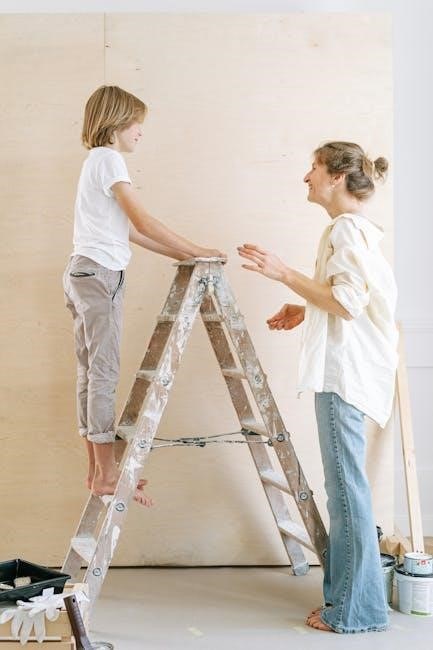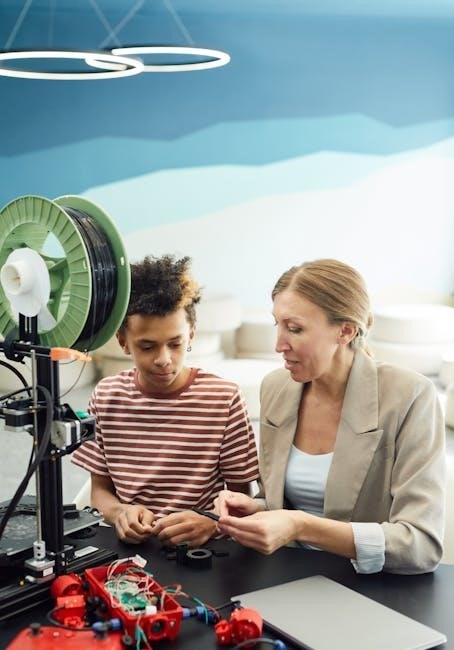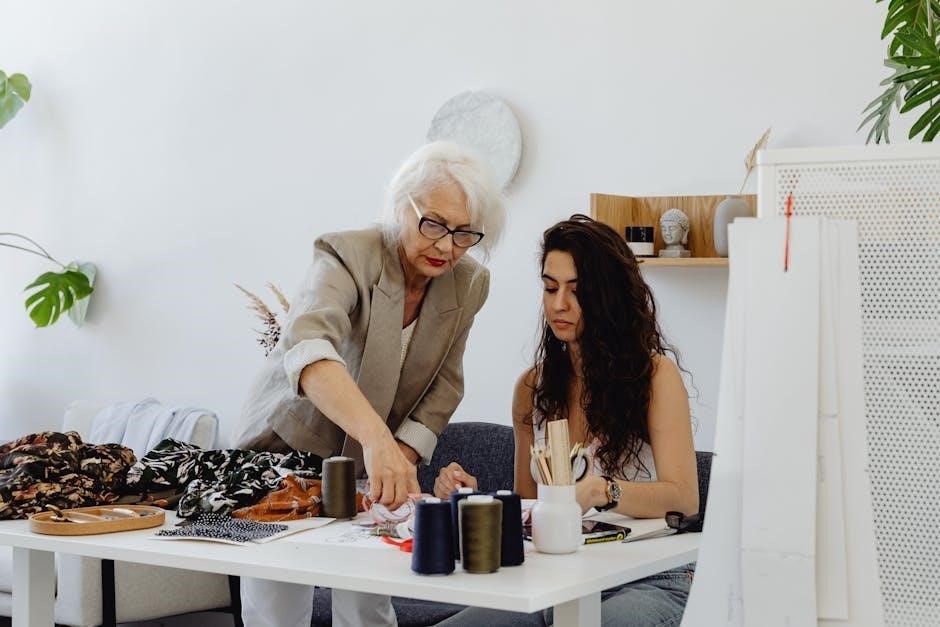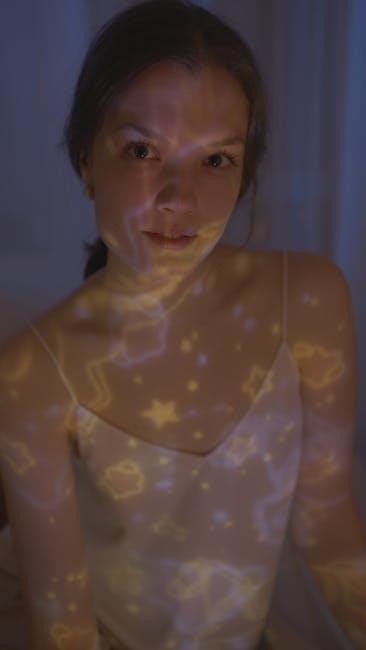Project Linus is a nonprofit organization providing handmade blankets to children in need, offering comfort and security․ Volunteers, called blanketeers, create these blankets using fabric, yarn, and batting, often incorporating quilting, knitting, or crocheting techniques․ The organization hosts events like Make-A-Blanket Day to engage communities in crafting and donating blankets for vulnerable children․
What is Project Linus?
Project Linus is a nonprofit organization dedicated to providing handmade blankets to children in need․ These blankets offer comfort, security, and warmth to vulnerable children, including those in hospitals, shelters, and foster care․ Volunteers, known as “blanketeers,” create the blankets using various techniques such as quilting, knitting, or crocheting․ The organization operates through local chapters, organizing events like Make-A-Blanket Day to engage communities in crafting and donating blankets․ Each blanket is a labor of love, designed to bring solace and hope to children during challenging times․
A Brief History of Project Linus
Founded in 1995 by Karen Loucks, Project Linus began as a local effort in Denver, Colorado, to provide security blankets for children in crisis․ Named after the Peanuts character Linus, who carried a security blanket, the organization quickly grew into a national network․ Over the years, chapters have formed across the U․S․, with volunteers creating thousands of handmade blankets annually․ The organization has become a symbol of community support, with events like National Make-A-Blanket Day fostering participation and donations․ Its history reflects a grassroots movement dedicated to comforting children through the gift of handmade blankets․

The Importance of Project Linus Blankets
Project Linus blankets provide comfort, security, and hope to children in crisis, serving as a tangible symbol of care and community support during difficult times․
Why Blankets Matter for Children in Need
Blankets hold profound significance for children in need, offering more than just physical warmth․ They provide emotional comfort, serving as a steadfast source of security and safety․ Often, these blankets become cherished security objects, akin to a favorite childhood blanket, offering a sense of familiarity and stability․ Handmade with care, each blanket conveys love and thoughtfulness, making children feel special and valued․ Beyond comfort, they can reduce anxiety and provide a sense of normalcy in chaotic situations․ Tactile comfort from soft fabrics can positively impact emotional well-being, boosting self-esteem and mental health․ Receiving a blanket reminds children they are seen and cared for, a powerful gesture that reinforces their worth․ Practicality also plays a role, as blankets offer stability across various settings—hospitals, shelters, or home․ They are a rare constant in uncertain circumstances, something to keep close․ The process of crafting these blankets with intention and care further enhances their significance, as each stitch sends a message of love and support․ Thus, Project Linus blankets are not just items of comfort; they are symbols of enduring care and compassion, providing solace and reassurance to children navigating difficult times․
Who Benefits from Project Linus Blankets
Project Linus blankets are designed to comfort children in need, including those in shelters, hospitals, foster care, and disaster situations․ These blankets also benefit children with serious illnesses, premature infants, and those experiencing trauma or loss․ Additionally, they support children in foster care transitions, providing a sense of security during uncertain times․ The blankets are tailored for various age groups, ensuring every child receives a blanket that suits their needs․ By donating these handmade items, Project Linus brings warmth, hope, and reassurance to children facing challenging circumstances, reminding them they are cared for and valued․
The Impact of a Handmade Blanket
A handmade Project Linus blanket provides more than physical warmth—it offers emotional comfort and reassurance․ For children facing difficult circumstances, these blankets become a source of security and hope․ The time and care invested in each stitch convey love and kindness, helping children feel valued and supported․ Many recipients hold onto their blankets for years, cherishing them as symbols of comfort during challenging times․ The impact extends beyond the child, fostering a sense of community and compassion among volunteers and donors who contribute to this meaningful cause․

Materials Needed for Making a Project Linus Blanket
Cotton or flannel fabric, batting, coordinating threads, and basic sewing tools like scissors, needles, and a sewing machine are essential for creating a Project Linus blanket․
Fabric Requirements for Blankets
Project Linus blankets require 100% cotton or cotton-blend fabrics, ensuring durability and softness․ Avoid thin, stretchy, or overly thick materials․ Fabrics should be pre-washed to remove sizing and dyes․ Patterns and colors should appeal to children, such as cartoon characters, animals, or vibrant designs․ Solids or coordinating prints work well for a cohesive look․ Fabric width should be at least 42 inches, with 1;5 to 2 yards recommended for standard blankets․ Larger blankets may require additional fabric․ Avoid using silk, wool, or vinyl, as they are not suitable for children’s blankets․
Batting and Layering Materials
Project Linus recommends using 100% cotton or 80/20 cotton-polyester batting for optimal warmth and comfort․ Batting should be thin, typically 1/4 inch thick, to ensure the blanket is lightweight yet cozy․ Layering materials are essential for a professional finish․ Place batting between the top fabric and backing fabric, ensuring smooth, even coverage․ Avoid thick or bulky batting, as it may make the blanket too heavy; Always pre-wash batting to prevent shrinkage․ Proper layering ensures the blanket is both functional and visually appealing, making it a cherished gift for children in need․
Threads, Yarns, and Notions
For Project Linus blankets, use high-quality threads, yarns, and notions to ensure durability and comfort․ Cotton threads are ideal for sewing, as they are soft and long-lasting․ Yarns are less commonly used but can add a decorative touch if chosen carefully․ Opt for soft, non-scratchy yarns in neutral colors․ Notions like rotary cutters, rulers, and sewing needles are essential for precise cutting and stitching․ Quilting gloves and thimbles can aid in handling fabric smoothly․ Avoid metallic or novelty yarns, as they may pose safety risks․ Always check with your local chapter for specific material preferences to ensure your blanket meets their guidelines․
Tools and Equipment
To create a Project Linus blanket, you’ll need essential tools like a sewing machine for stitching and a rotary cutter for precise fabric cutting․ A self-healing mat and a ruler ensure accurate measurements․ Sharp scissors and a reliable iron with a spacious ironing board are vital for pressing seams․ Quilting hoops and batting clips help manage layers during quilting․ Optional tools include a walking foot for heavy fabrics and a serger for finishing seams․ High-quality tools enhance both the process and the blanket’s durability․ Always ensure your equipment is in good condition to maintain the quality of your handmade blanket․

Blanket-Making Instructions
Start by selecting patterns, preparing fabric, and layering materials․ Stitch layers together, quilt, and bind edges․ Add personal touches before finishing and donating to Project Linus․
Step-by-Step Guide to Making a Quilt
Start by selecting fabric, cutting it into squares or strips for the quilt top․ Sew pieces together, forming rows or blocks․ Layer the quilt top, batting, and backing․ Pin securely, then quilt by hand or machine․ Trim excess batting and backing․ Bind edges with fabric strips, folding for a clean finish․ Add a label or personal touch․ Ensure all seams are secure and corners are square․ Follow Project Linus guidelines for size and materials․ This step-by-step process ensures a cozy, well-made quilt for a child in need, providing comfort and warmth through your craftsmanship․
How to Prepare Fabric for Sewing
Start by washing and drying fabric to remove sizing and soften fibers․ Iron fabric while still slightly damp to eliminate wrinkles․ Cut fabric into precise shapes or strips using rotary cutters and mats for accuracy․ Ensure all edges are straight and seams align properly․ Pre-treat any special fabrics like fleece or flannel according to their care instructions․ Remove selvage edges to prevent shrinkage․ Use scissors or rulers for smaller cuts․ Organize fabric pieces neatly before sewing to streamline the process․ This preparation ensures a smooth and professional finish for your Project Linus blanket․
Layering and Quilting Techniques
Begin by layering the backing fabric, batting, and quilt top on a flat surface․ Pin or use spray adhesive to secure the layers․ For quilting, use a sewing machine or hand-stitch with a needle and thread․ Simple straight-line stitching or free-motion patterns work well․ Keep stitches consistent for a professional finish․ For hand-tied blankets, use yarn or embroidery floss to create knots at evenly spaced intervals․ Ensure quilting is tight enough to hold layers together without being too stiff․ These techniques ensure the blanket is secure, warm, and durable for children in need․

Binding the Blanket
Binding adds a decorative finish and protects the blanket’s edges․ Cut 2-3″ wide strips of fabric for the binding․ Sew strips together diagonally to create one long piece․ Fold the binding in half lengthwise and press․ Attach it to the blanket’s edges using a 1/4″ seam allowance․ Fold the binding over twice to cover the raw edge and sew in place․ For a polished look, miter the corners by folding the binding at a 45-degree angle․ Use a walking foot or zigzag stitch to secure the binding neatly․ This step ensures the blanket is durable and visually appealing for the recipient․
Adding a Personal Touch
A personal touch makes a Project Linus blanket extra special․ Consider adding embroidery with the recipient’s name or a heartfelt message․ Appliques, such as cute animals or stars, can delight children․ Quilting patterns like hearts or flowers add a loving detail․ Some volunteers include a small label with their name or a meaningful phrase․ These personal elements create a sense of thoughtfulness and love, making the blanket more than just a warm cover—it becomes a cherished gift․ This step allows you to infuse your blanket with unique character and emotional significance for the child who will receive it․

Donation Guidelines

Donation guidelines ensure your blanket meets Project Linus standards, helping it reach those in need effectively and make a meaningful difference in their lives․
Where to Donate Your Blanket
Your handmade blanket can be donated to local Project Linus chapters, which distribute them to children in need․ Visit the official Project Linus website to find a chapter near you by entering your ZIP code․ Many chapters also accept blankets at local hospitals, shelters, or community centers․ Additionally, some chapters host events or drop-off locations where you can hand-deliver your blanket․ Contacting your local chapter directly ensures your donation reaches those who need it most․ This process makes it easy to contribute to the mission of providing comfort and warmth to children․
How to Prepare Your Blanket for Donation
To prepare your blanket for donation, ensure it is clean and free of loose threads or imperfections․ Wash and dry the blanket using mild detergent without fabric softener, as this can irritate sensitive skin․ Fold or roll the blanket neatly and place it in a clean, protective bag․ Include a personalized note or label if desired․ Finally, deliver the blanket to your local Project Linus chapter or designated drop-off location․ Proper preparation ensures the blanket is ready to provide comfort to a child in need․
Local Project Linus Chapters
Project Linus has numerous local chapters across the country, each serving specific geographic areas․ These chapters are run by dedicated volunteers who organize blanket-making events, collect donations, and distribute blankets to children in need within their communities․ To find a local chapter, visit the official Project Linus website and search by state or zip code․ Joining a local chapter is a great way to connect with other volunteers, participate in events, and make a meaningful impact in your area․ Chapters often host workshops, sewing days, and donation drives to support their mission․

Events and Participation
Project Linus hosts events like Make-A-Blanket Day, bringing communities together to sew and donate blankets․ These events foster connection and provide opportunities to give back․
Make-A-Blanket Day
Make-A-Blanket Day is a national event where volunteers gather to create handmade blankets for children in need․ Organized by Project Linus, it brings communities together to sew, quilt, and knit․ Participants of all skill levels are welcome, from experienced crafters to beginners․ The event emphasizes the joy of giving while teaching others about the importance of homemade blankets․ Workshops and supplies are often provided, making it accessible for everyone․ This heartfelt initiative not only produces comforting blankets but also fosters connections and spreads awareness about the impact of kindness․ Joining Make-A-Blanket Day is a rewarding way to make a difference․
How to Host a Blanket-Making Event
Hosting a blanket-making event for Project Linus is a rewarding way to bring your community together while creating comfort for children in need․ Start by defining your event’s purpose and audience․ Secure a venue, gather materials like fabric, threads, and sewing tools, and promote the event through social media and local craft stores․ On the day, set up stations for fabric selection, sewing, and quilting․ Provide refreshments and guidance for participants of all skill levels․ Conclude by showcasing the finished blankets and distributing them to local recipients․ Follow up with thank-you notes and photos to celebrate the impact of your event․

Getting Involved in Your Community
Engaging with your community through Project Linus is a meaningful way to give back while fostering connections․ Start by locating your local chapter or organizer to learn about upcoming events or volunteer opportunities․ Share your sewing skills by teaching others or collaborating on group projects․ Participate in local drives for fabric donations or monetary contributions to support blanket-making efforts․ Encourage friends, family, or coworkers to join, amplifying the impact․ By staying active and involved, you help provide comfort and warmth to children in need while strengthening community bonds and fostering a sense of shared purpose․

Tips for Making the Best Blankets
Use high-quality, soft fabrics and ensure accurate measurements․ Secure stitching and tight seams guarantee durability․ Add personal touches like embroidery or appliques for a unique, heartfelt finish․
Choosing the Right Patterns
Selecting the right pattern is crucial for creating a Project Linus blanket․ Opt for simple, durable designs suitable for children․ Patterns with bright, cheerful colors and basic shapes are ideal․ Avoid overly complex designs that may be difficult to sew or uncomfortable for children․ Consider seasonal or themed patterns to match holidays or special occasions․ Ensure the pattern aligns with the child’s age and preferences․ Always use patterns recommended by Project Linus or those designed for charity quilts․ This ensures the blanket is both functional and heartfelt, providing comfort to those in need․
Size and Measurement Guidelines
Project Linus blankets should be made to specific size guidelines to ensure they are suitable for children․ The recommended sizes range from 30×40 inches for infants to 40×60 inches for older children․ Avoid blankets smaller than 24×24 inches, as they may be too tiny for comfort․ For larger blankets, 50×70 inches is the maximum recommended size․ Use a quilt ruler or measuring tape to ensure accuracy․ Precise measurements are essential to create blankets that provide both comfort and security for children in need․ Always follow these guidelines to meet the needs of the recipients effectively․
Personalizing Your Blanket
Personalizing your Project Linus blanket adds a heartfelt touch for the child who receives it; Consider adding a small label or embroidery with your name or a meaningful message․ Using fabric featuring the child’s interests, such as cartoons or animals, can make the blanket extra special․ Appliques or simple embroidery can also add personality․ Keep personalization simple to ensure the blanket remains durable and washable․ A personalized note or card included with the blanket can further brighten a child’s day, making the gift even more meaningful and unique․
Creating a Project Linus blanket is a meaningful way to bring comfort and joy to children in need․ Each handmade blanket serves as a tangible symbol of love and hope․ By following the guidelines and tips provided, you can craft a cozy, high-quality blanket that will make a difference in a child’s life․ Whether you’re sewing, quilting, or donating, your contribution supports a noble cause․ Join the Project Linus community today and help spread warmth and kindness, one blanket at a time․ Your effort truly makes a lasting impact․